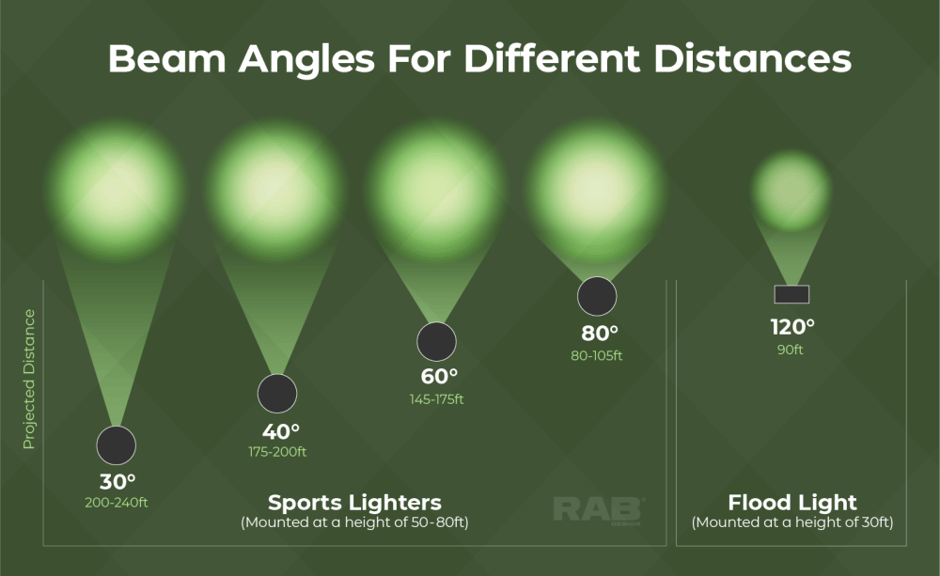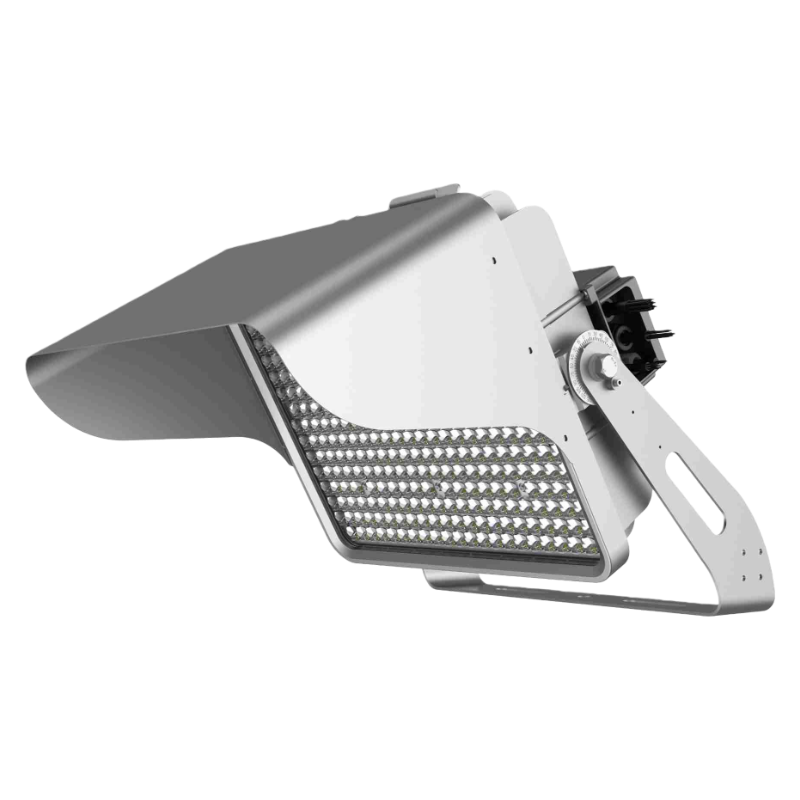Lighting Outdoor Sports - General Purpose Flood vs Sports Lighters
While both general floodlights and sports lighting aim to illuminate large outdoor areas, there are significant differences in their design, performance, and application due to the highly specialized needs of sports venues.
Higher Lumen Output
One big difference is that sports flood lights tend to be the higher-end option. Sports flood lights generally deliver higher lumens, sometimes over 100,000 lumens. A big benefit of the higher lumens is that the sports flood lights can be mounted at larger distances and heights. These lights need to be able to perform, even if they are 100 feet in the air, for example, if they are mounted on a pole overlooking a football field. Sports lighting is designed to project a beam of light out a certain distance and from a certain mounting height (See chart 1 below). Flood lighting, on the other hand, is designed to illuminate at a shorter distance out from the pole or mounting location.
General-purpose floods usually go up to about 60,000 lumens and are ideal for mounting heights of 20 to 40 feet. As stated earlier, this means for mounting heights greater than, specialty sports floods provide a significantly higher lumen output.
Higher lumen output is derived through higher wattage or more power being consumed by the fixture. A good metric when comparing fixtures is efficacy, or lumens per watt, or LPW. RAB Design's sports light has an efficacy of 150 lumens per watt. It is DLC 5.1 Premium, which is key to securing rebates, depending on your region.
Different Beam Patterns and Options
Sports flood lights will typically have more options for beam patterns compared to regular floods, as sports floods need to have a much larger variety of patterns and angles to fit how they are being used. The narrow beams are needed to project the light out a greater distance, 200 to 240 feet, the 60-degree angle reaches 145 feet to 175 feet, and the 80-degree beam would be under 105 feet (see chart 1). In a way, a sports flood light is really more like a spotlight that is projecting light out to a certain spot, while a general-purpose flood light is just looking to spread the light out.
A clear example of why the angle of the beam pattern is so important for a sports flood compared to a regular flood can be seen in the example of lighting up a baseball diamond. For areas that need greater amounts of light, you need better control of that beam of light. In this example, on a baseball diamond, the outfield poles would require a narrow beam of light 20 degrees to illuminate from the bases back towards the poles, along with a wide 80-degree beam to illuminate out to 80 feet from the pole.
Let’s say there’s a pop fly and the outfielder is looking upwards to catch the ball; the last thing you want is for the player to be blinded by the light. Being able to configure the beam to shine at an angle that avoids this problem is key for sports floods.

Weight & Footprint
Sports lights have a larger footprint and weigh more compared to regular floods. This is an important consideration for Installers
If you found this blog useful, stay tuned for the next blog covering sports flood lights coming out soon!
While both general floodlights and sports lighting aim to illuminate large outdoor areas, there are significant differences in their design, performance, and application due to the highly specialized needs of sports venues.
Here's a breakdown of the key distinctions:
1. Purpose and Application:
-
General Floodlights:
- Designed for broad, general illumination of large outdoor spaces for safety, security, and visibility.
- Commonly used for:
- Parking lots
- Building facades and architectural highlighting
- Gardens and landscapes
- General security lighting
- Construction sites (temporary lighting)
- Warehouses and industrial areas
-
Sports Lighting:
- Specifically engineered to meet the demanding requirements of various sports, ensuring optimal visibility for players, officials, and spectators, as well as for broadcasting.
- Used for:
- Baseball/softball fields
- Football/soccer fields
- Tennis courts
- Basketball courts
- Hockey rinks
- Track and field venues
- Other outdoor sports facilities
2. Lumen Output (Brightness):
- General Floodlights: Typically produce 3,000 to 60,000 lumens. They are designed for mounting heights of 20 to 40 feet.
- Sports Lighting: Have significantly higher lumen outputs, often ranging from 65,000 to over 160,000 lumens per fixture. This is necessary to illuminate large playing surfaces from greater mounting heights (e.g., 40-100+ feet for large stadiums).
3. Beam Pattern and Light Distribution:
- General Floodlights: Usually have a wide or very wide beam spread (45-130 degrees) to cover a large area with relatively uniform light for general purposes. The light tends to diffuse more over distance.
- Sports Lighting: Offer a much broader range of beam patterns (e.g., narrow 10-20 degrees, to wider 60-80 degrees). They are designed for precise control of light distribution to achieve high uniformity across the playing surface, minimize shadows, and prevent glare for players and spectators. They act more like spotlights, projecting light accurately over long distances.
4. Light Quality and Uniformity:
- General Floodlights: Provide adequate light levels for general safety and visibility, but uniformity might be less critical. You might see more "hot spots" and shadows.
- Sports Lighting: Prioritize extreme uniformity of light across the entire playing area. They aim to eliminate shadows and ensure consistent brightness, which is crucial for fast-paced sports where players need to track objects and see clearly in all directions. Requirements are often expressed as uniformity ratios (e.g., 1.5:1 or 2:1 for professional play).
5. Glare Control:
- General Floodlights: While some glare control might be present, it's not as critical as in sports lighting.
- Sports Lighting: Incorporate advanced optics and shielding to minimize glare for players, officials, and spectators. Blinding glares can be dangerous and disrupt gameplay.
6. Durability and Weather Resistance:
- General Floodlights: Are generally built to withstand outdoor elements (e.g., IP65 rating for dust and water resistance).
- Sports Lighting: Need to be exceptionally robust and weather-resistant due to their high mounting heights and exposure to harsh conditions. They often have higher IK ratings (impact protection) to withstand potential impacts from balls or other objects.
7. Surge Protection:
- General Floodlights: May have basic surge protection.
- Sports Lighting: Typically come with higher surge protection due to their outdoor exposure (especially to lightning strikes at greater heights) and the high cost of maintenance/replacement.
8. Control Capabilities:
- General Floodlights: May have basic on/off controls, sometimes with motion or dusk-to-dawn sensors.
- Sports Lighting: Often feature sophisticated control systems for dimming, scheduling, and adjusting light levels for different sports or competition levels. Many offer wireless control capabilities.
In summary:
Think of general floodlights as providing a "wash" of light for broad coverage. Sports lighting, on the other hand, is like a precisely engineered system of "spotlights" designed to meet stringent illumination standards for specific athletic activities, prioritizing brightness, uniformity, glare control, and durability in challenging environments. The investment in sports lighting is typically much higher due to these specialized requirements.











